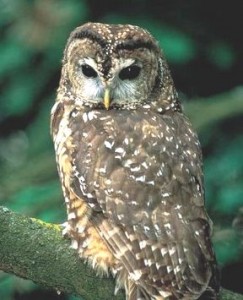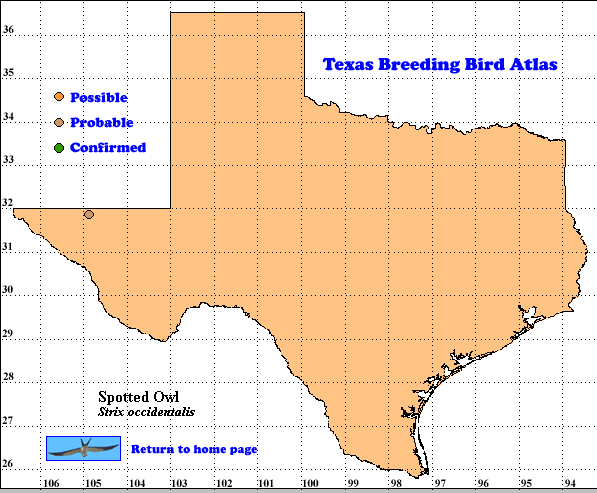Spotted Owl is a complex of several groups in western Canada, the western United States and Mexico. Gutierrez et al. (1995) suggest 3 groups at the species or subspecies level on the basis of mtDNA sequencing and other factors. The Mexican Spotted Owl (S. o. lucida) is resident in the southern Rocky Mountains and the highlands of north and central mainland Mexico. California Spotted Owl (S. o. occidentalis) is found in the Sierra Nevada Mountains, the California coast range (south of San Francisco Bay) and higher mountains in northern Baja California. The Northern Spotted Owl (S. o. caurina) is found from British Columbia south through the coast range to northern California.
The AOU checklist (Am. Ornithol. Union 1998) recognizes 2 genetically distinct forms, the California Spotted-Owl (S. occidentalis) of the Pacific Coast, and Mexican Spotted- Owl (S. lucida), see range above.
The more aggressive Barred Owl (S. varia) has expanded its range into southwestern Canada and down the Pacific Coast to California, competing and hybridizing with the Spotted Owl, adding further to the problems facing the Spotted Owl whose Northern and Mexican groups are federally listed as “threatened” (Gutierrez et al. 1995, Buchanan 2005a, 2005b).
DISTRIBUTION. During the TBBA project field work in 1987-1992, atlasers found 1 probable and 2 possible breeding records in latilong 31104 (the Guadalupe Mountains). Oberholser (1974) reported F. R. Gelbach described the species as a resident and a very likely breeder in the Guadalupe Mountains.. Pairs have been recorded from McKittrick Canyon and The Bowl. Lockwood and Freeman (2004) report this owl as rare and local in both the Davis and Guadalupe mountains.
The breeding range of the Spotted Owl extends from British Columbia south on the Pacific Coast to northern Baja California, Mexico. This owl also breeds from Utah and Colorado south through Arizona. New Mexico and mainland Mexico north of the Isthmus of Tehuantepec (Gutierrez et al. 1995, Howell and Webb 1995).
SEASONAL OCCURRENCE. The Spotted Owl is a permanent resident in the Guadalupe and Davis mountains. In fall and winter this owl has also been reported in El Paso County (Oberholser 1974, Lockwood and Freeman 2004). In Arizona breeding activity was reported from May 1 to September 10 with a peak in late July (Wise-Gervais 2005). In Colorado breeding activity was found from May 6 to July 20 (Boyle11998).
BREEDING HABITAT. Spotted Owls have been reported from the Guadalupe Mountains at elevations ranging from 2100 to 2600 m (7000 to 8500 ft) where the species inhabits shady canyons with pines and Douglas firs (Oberholser 1974).
In Arizona 45% of breeding reports for this owl came from mixed conifer forests (Douglas fir, white fir and ponderosa pine), 17% from montane riparian habitats and 10% from areas of ponderosa pine (Wise- Gervais 2005). In Colorado 42 % of breeding reports came from ponderosa pine and pinyon-juniper woodlands, 33% from upland conifer forests, and 14% were in montane and riparian deciduous habitats (Boyle11998).
Mexican Spotted Owls (the group present in Texas) may nest in a wider variety of sites than other subspecies, narrow canyons, cliff ledges and mistletoe clumps. Pairs use nests of other species, and may use the same nest every year or in alternate years or a different nest every year. These owls scrape out a depression in the debris in an existing nest. The female lays her eggs on a layer of detritus, feathers, prey bones and owl pellets. The most common clutch is 2 smooth, white to pearly gray eggs. The female incubates the eggs for about 30 days and the young generally leave the nest about 34-36 days after hatching. They remain with their parents for another 60-90 days (Harrison 1979, Gutierrez et al.1995).
STATUS. Lockwood and Freeman (2004) consider Spotted Owl a rare and local resident in wooded canyons in the Guadalupe and Davis mountains of Trans-Pecos Texas. The Breeding Bird Survey does not sample this nocturnal owl. Protection of considerable habitat in Texas within state and federal parks is a plus for the future of this owl in this state, but increasing temperatures and the possibility of decreasing precipitation make the future of species whose Texas range is limited to the Trans-Pecos mountains a concern.
Text by Robert C. Tweit (2006).
Literature cited.
Boyle, S. 1998. Spotted Owl (Strix occidentalis). In Colorado breeding bird atlas, pp. 230-231 (H. E. Kingery, ed.), Colorado Bird Atlas Partnership, Denver.
Buchanan, J. B. 2005a. Spotted Owl (Strix occidentalis). In Birds of Washington, pp 217-218 (T. R. Wahl, B. Tweit and S. G. Mlodinow, eds.), Oregon State Univ. Press, Corvallis.
Buchanan, J. B. 2005b. Barred Owl (Strix varia). In Birds of Washington, pp 218-220 (T. R. Wahl, B. Tweit and S. G. Mlodinow, eds.), Oregon State Univ. Press, Corvallis.
Gutierrez, R. J., A. B. Franklin and W. S. LaHaye. 1995. Spotted Owl (Strix occidentalis). In The birds of North America, No. 179 (A. Poole and F. Gill, eds.). The Birds of North America, Inc., Philadelphia, PA.
Harrison, H. H. 1979. A field guide to western birds’ nests. Houghton Mifflin, Boston, MA.
Howell, S. N. G. and S. Webb. 1995. A guide to the birds of Mexico and northern Central America. Oxford University Press, New York.
Lockwood, M. W. and B. Freeman. 2004. The TOS handbook of Texas birds. Texas A&M University Press, College Station.
Oberholser, H. C. 1974. The bird life of Texas. University of Texas Press, Austin.
Wise-Gervais, C. 2005.Spotted Owl (Strix occidentalis ). In Arizona Breeding Bird Atlas. pp. 224-225 (T. E. Corman and C. Wise-Gervais, eds.), University of New Mexico Press, Albuquerque.

